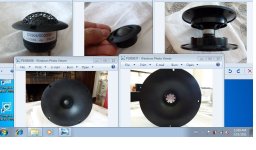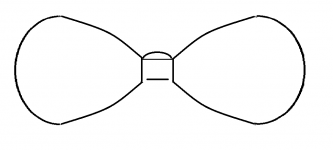Thanks! This is very informative. If it's not too much trouble, would you also post the impulse response and frequency response of the B&C?
Sure
DE250 on Dayton 10" WG:


... as in "Magnesium"
Just arrived today!

Getting closer to Orion by the day!
Woa, only now ?!? Did the postman swim from NZ ?
I wish you a lot of fun with it !
No, that would be a bit quicker
... so I hastily implement these new drivers tonight !!

Nothing special about the speakers except that attention had been given to the tweeter's polar response to get rid of Klingon warship polar response
The W22s looks awesome IRL. Period.
Now for some initial impression... First of all when I tap the cone of these Excels, interestingly they don't sound like typical metal cone. They sound like polycones! Magnesium are lighter than aluminium and apparently Seas were able to make a thicker cone for the same weight, providing better damping.
Replacing the Aluminium L21RNX/P there were only 2 differences. The cone resonance peak (W22 is about 100hz higher) and region between 1khz-2khz. Frequency response-wise they track within 1-2db. It was also interesting to note the behaviour of the resonance. It's different. The Aluminium has periodic resonance after the main one, while W22 has only one major peak and drops after that. Both L21 and W22 have serious drop about 2khz and really the 1.5khz XO is really pushing it.
SONICS!!
Now, after only one adjustment, which is the metal cone notch I sat down and listen.... Tonally they are inseparable. They sounded very much the same. However the Excel have this specific character that is quite difficult to explain. Basically it sounded mellow and laid back, but with resolution and transparency. It projects refinement and practically makes any music with overtones sounds......beautiful?? They really reminded me of the Orions.
I think, however that the Excels are lacking the gusto of the Aluminium L21 especially playing percussive instruments. I haven't given them justice yet though, as I don't want to wake up the neighbours. We'll se how they fire up at full pelt! . I'd be interested later to test both with burst signal and see what's happening here.... W22's cone is indeed a little bit heavier than L21's.
Based on what you describe I can imagine now pretty well how they sound !
That is the salt in the speaker soup. It is something, no text book can cater for, such experiences.
So have merci with your neighbors until daylight
I allowed myself a pair of R16RN-SL but did not listen to them yet. One has a dent and needs to be replaced.
About the Klingon polar response: I have a theory that says it might be benign or even beneficial if it follows a certain pattern. But I need some time to prove it to myself, first.
Enjoy the new sound !
That is the salt in the speaker soup. It is something, no text book can cater for, such experiences.
So have merci with your neighbors until daylight
I allowed myself a pair of R16RN-SL but did not listen to them yet. One has a dent and needs to be replaced.
About the Klingon polar response: I have a theory that says it might be benign or even beneficial if it follows a certain pattern. But I need some time to prove it to myself, first.
Enjoy the new sound !
Some considerations (guessings):
1. With DE250 on the WG, you have the opportunity to remove the rear cap to have some rear-firing HF. Maybe good, maybe not. But at least it's very easy to try.
2. Have you thought about rear-mounting for the mid? It might help on physical alignment of mid-tweeter. As the WG is shallow, there's a chance to align them. Again, maybe good, maybe not. And there's more hassle than the above (as you've done the rear chamfer)...
BTW, nice baffles
1. With DE250 on the WG, you have the opportunity to remove the rear cap to have some rear-firing HF. Maybe good, maybe not. But at least it's very easy to try.
2. Have you thought about rear-mounting for the mid? It might help on physical alignment of mid-tweeter. As the WG is shallow, there's a chance to align them. Again, maybe good, maybe not. And there's more hassle than the above (as you've done the rear chamfer)...
BTW, nice baffles
Pics for Gainphile. A dipole dome tweeter. Remove front screen and rear chamber from scan speak D2904 600000. Light trim of a monacor waveguide then fit to the front, and a second waveguide has glove fit at the rear straight out of the box. Front looks normal, rear shows the core structure of the magnet support with its rear vents which in this case provide the rear radiation. Better measurements systems and ears than mine might find the issues but it works for me. Russell.
That would probably kill the low end of the tweeter.Some considerations (guessings):
1. With DE250 on the WG, you have the opportunity to remove the rear cap to have some rear-firing HF. Maybe good, maybe not. But at least it's very easy to try.
...and polars to compare with what Rudolf did once with a front and back firing combo.
BTW, Russel that's really well done
BTW, Russel that's really well done
Second attempt at Pics for gainphile, finger trouble missed the pics.
Thank you very very much Russell!
That is a very interesting approach. What are the WGs and how big are they? It would be interesting if they can hold directivity down to 1.5khz... That would be "solution to a problem" indeed
Edit: .. found it, Monacor waveguide!
Dipole dome tweeter pics for Gainphile.
The purchased waveguide is 168mm. The outer edges of the guide are 89mm apart, and the gap is (was) filled to smooth the edge and increase the diameter hence cut off frequency. The purchased waveguide was close enough to my analytic prototype derived target: a 240mm OD toroid with 120mm diameter cross section, and oblate speroid transition to the dome. The doe is at the front, and the acoustic cavity at the rear appears trivial - ref below.
I used paper mache to form the torroid for the proto tests, as it has worked (for me) the next step is making the toroid for the tweeter and the mid in a more visually appealing structure. The mid also has a torroid like form, rather than a circular cross section it has an 90 x 54mm elipse, and the ellipse rotates so that it forms a moebius, for aesthetics. I am making it by using thin plywood sections set on a central frame then fill with foam, shaped and covered; like a model airplace wing mated with a surfboard.
The measurements I have are here amongst hundreds of spreadsheets of single points data. Making one plot that would make sense to another person is not on my list of pleasurable activities so I will decline the offer of producing a report. My data analysis discounted higher volumes (I only have a small apartment and rather than an SL like 90 dB I settled for 87) and my hearing is second rate above 13KHz. Others might find something where I wouldnt have looked.
The purchased waveguide is 168mm. The outer edges of the guide are 89mm apart, and the gap is (was) filled to smooth the edge and increase the diameter hence cut off frequency. The purchased waveguide was close enough to my analytic prototype derived target: a 240mm OD toroid with 120mm diameter cross section, and oblate speroid transition to the dome. The doe is at the front, and the acoustic cavity at the rear appears trivial - ref below.
I used paper mache to form the torroid for the proto tests, as it has worked (for me) the next step is making the toroid for the tweeter and the mid in a more visually appealing structure. The mid also has a torroid like form, rather than a circular cross section it has an 90 x 54mm elipse, and the ellipse rotates so that it forms a moebius, for aesthetics. I am making it by using thin plywood sections set on a central frame then fill with foam, shaped and covered; like a model airplace wing mated with a surfboard.
The measurements I have are here amongst hundreds of spreadsheets of single points data. Making one plot that would make sense to another person is not on my list of pleasurable activities so I will decline the offer of producing a report. My data analysis discounted higher volumes (I only have a small apartment and rather than an SL like 90 dB I settled for 87) and my hearing is second rate above 13KHz. Others might find something where I wouldnt have looked.
Attachments
Just trying to understand the photo of the 2904 in the waveguide, specifically what "might" be the back photo with what looks like the motor structure with a series of holes around the edge.
Is this the motor?
How much output can one expect from those tiny holes compared to the front dome?
Great work
Cheers
Dean
Is this the motor?
How much output can one expect from those tiny holes compared to the front dome?
Great work
Cheers
Dean
Hi guys
I read briefly through this post (reading it on a cellphone, so it is difficult to see everything), and one thing came to my mind: a lot was said about the B&G Neo3 at the beginning of the post, so has anyone thought of maybe loading both the front and the rear sides directly with two Dayton waveguides (10-inch WGs maybe)? Mounting this structure on a baffle might be tricky, and I am not sure how this loading will affect the Neo3, but then you'd have true DI-pole (as opposed to BI-pole) loading. Any thoughts?
Enjoy,
Deon
I read briefly through this post (reading it on a cellphone, so it is difficult to see everything), and one thing came to my mind: a lot was said about the B&G Neo3 at the beginning of the post, so has anyone thought of maybe loading both the front and the rear sides directly with two Dayton waveguides (10-inch WGs maybe)? Mounting this structure on a baffle might be tricky, and I am not sure how this loading will affect the Neo3, but then you'd have true DI-pole (as opposed to BI-pole) loading. Any thoughts?
Enjoy,
Deon
- Status
- This old topic is closed. If you want to reopen this topic, contact a moderator using the "Report Post" button.
- Home
- Loudspeakers
- Multi-Way
- S16 - Constant Directivity Dipoles

